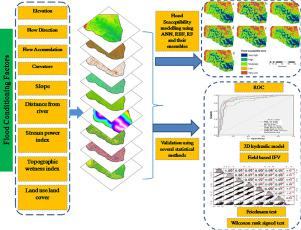Geoscience Frontiers ( IF 8.5 ) Pub Date : 2021-02-22 , DOI: 10.1016/j.gsf.2021.101175 Susanta Mahato , Swades Pal , Swapan Talukdar , Tamal Kanti Saha , Parikshit Mandal

|
The flood hazard management is one of the major challenges in the floodplain regions worldwide. With the rise in population growth and the spread of infrastructural development, the level of risk has increased over time. Therefore, the prediction of flood susceptible area is a key challenge for the adoption of management plans. Flood susceptibility modeling is technically a common work, but it is still a very tough job to validate flood susceptible models in a very rigorous and scientific manner. Therefore, the present work in the Atreyee River Basin of India and Bangladesh was planned to establish artificial neural network (ANN), radial basis function (RBF), random forest (RF) and their ensemble-based flood susceptibility models. The flood susceptible models were constructed based on nine flood conditioning parameters. The flood susceptibility models were validated in a conventional way using the receiver operating curve (ROC). To validate the flood-susceptible models, a two dimensional (2D) hydraulic flood simulation model was developed. Also, the index of flood vulnerability model was developed and applied for validating the flood susceptible models, which was a very unique way to validate the predictive models. Friedman test and Wilcoxon Signed rank test were employed to compare the generated flood susceptible models. Results showed that 11.95%–12.99% of the entire basin area (10188.4 km2) comes under very high flood-susceptible zones. Accuracy evaluation results have shown that the performance of ensemble flood susceptible models outperforms other standalone machine learning models. The flood simulation model and IFV model were also spatially adjusted with the flood susceptibility models. Therefore, the present study recommended for the ensemble flood susceptibility prediction and IFV based validation along with conventional ways.
中文翻译:

基于现场的洪水脆弱性指数(IFV):针对洪水敏感模型的新验证技术
洪水灾害管理是全球洪泛区的主要挑战之一。随着人口增长和基础设施发展的扩散,风险水平随着时间的推移而增加。因此,对洪水易感区域的预测是采用管理计划的关键挑战。洪水敏感性建模在技术上是一项常见的工作,但是以非常严格和科学的方式验证洪水敏感性模型仍然是一项艰巨的工作。因此,目前计划在印度和孟加拉国的阿特里河流域开展工作,以建立人工神经网络(ANN),径向基函数(RBF),随机森林(RF)及其基于集合的洪水敏感性模型。基于九个洪水条件参数构建了洪水敏感模型。使用接收器工作曲线(ROC)以常规方式验证洪水敏感性模型。为了验证洪水敏感性模型,开发了二维(2D)水力洪水模拟模型。同时,开发了洪水脆弱性模型的指标并将其用于验证洪水易感性模型,这是验证预测模型的一种非常独特的方法。使用Friedman检验和Wilcoxon Signed秩检验来比较生成的洪水敏感模型。结果表明,整个流域面积(10188.4 km,占11.95%–12.99%)开发了洪水脆弱性模型指数并将其用于验证洪水易感性模型,这是验证预测模型的一种非常独特的方法。使用Friedman检验和Wilcoxon Signed秩检验来比较生成的洪水敏感模型。结果表明,整个流域面积(10188.4 km,占11.95%–12.99%)开发了洪水脆弱性模型指数,并将其用于验证洪水易感性模型,这是验证预测模型的一种非常独特的方法。使用Friedman检验和Wilcoxon Signed秩检验来比较生成的洪水敏感模型。结果表明,整个流域面积(10188.4 km,占11.95%–12.99%)2)处于很高的洪灾敏感区之下。准确性评估结果表明,集成泛洪敏感模型的性能优于其他独立的机器学习模型。洪水敏感性模型还对洪水模拟模型和IFV模型进行了空间调整。因此,本研究建议采用常规方法进行整体洪水敏感性预测和基于IFV的验证。









































 京公网安备 11010802027423号
京公网安备 11010802027423号